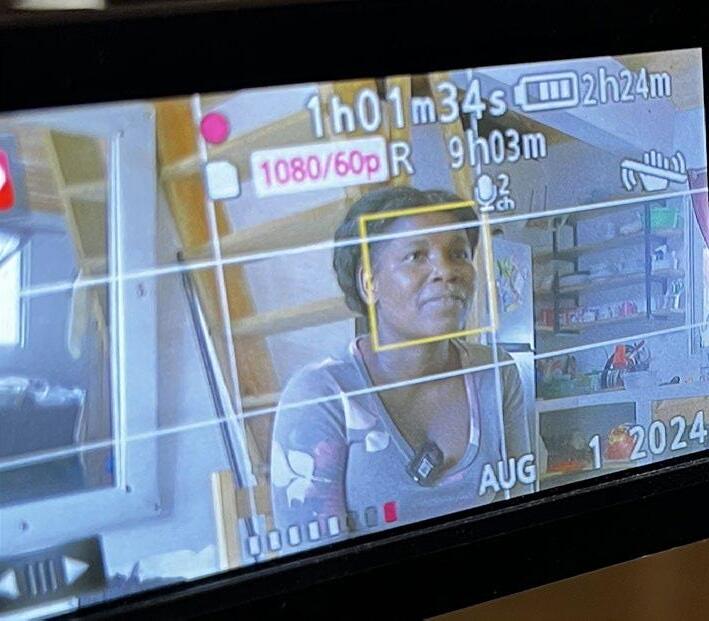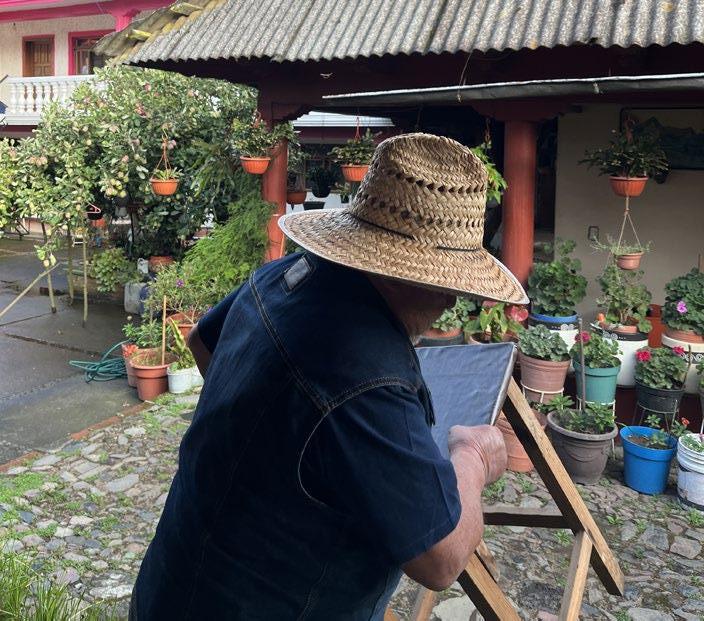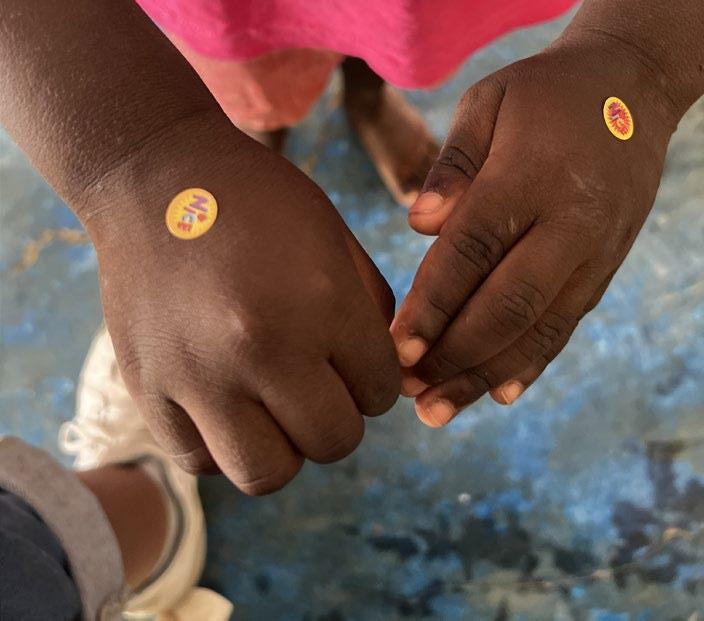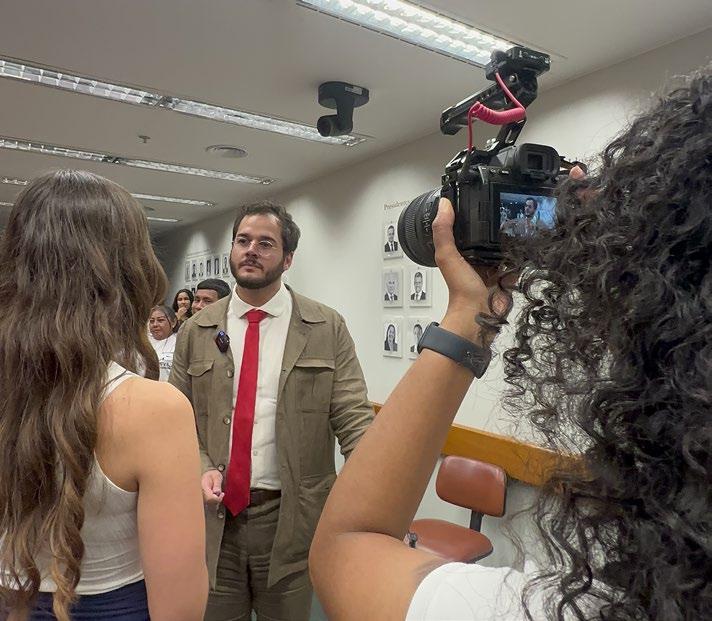
8 minute read
MALAS students craft documentary films for capstone projects
Visual storytelling offers advantages, challenges for communicating research
As they develop their research projects, most MALAS students opt to channel their results into a written thesis. But in the MALAS 2025 cohort, three students—Rebeca Almonacid Leal, María de la Cruz Mora, and Diana Rodríguez Allende—have chosen to create documentary films from their fieldwork research. Read on to learn why Rebeca, María, and Diana decided to use visual storytelling to communicate their research, and why this path is more challenging than it might seem.
Q: What is your research project and what is the visual element?
MARÍA DE LA CRUZ MORA: I went in looking for post-NAFTA trade policies that might be contributing to changes in customs and traditions in Michoacán, Mexico. But when I got there, being in the community, having all these visuals and interviews, I realized I had to look at pre-NAFTA, too. It became a story about how people are adapting to changes because of policies, getting testimonials about their lived experiences through different historical changes. I wanted to be able to show the community: the transformation in landscape, what the avocado orchards look like, what the traditions are like. I went during the prime religious festival of San Antonio and recorded everything on the day celebrating the agriculture sector. You can see people in processionals, how they're dressed, what the music is like.
DIANA RODRÍGUEZ ALLENDE: My project centers around the Dominican-Haitian conflict, and the lived experiences of Haitian migrants residing in the Dominican Republic, as well as the perceptions Dominicans themselves have of that population. I visited a lot of the bateyes where Haitian immigrants reside; they’re like refugee settlements, but Haitians are not really considered refugees in Dominican Republic because of the historical hostility that is still very tense today. I wanted to create a documentary because I thought it'd be the best way to reach wider audiences outside of academia. There are not a lot of people who will read a 50-page thesis, so I wanted to reach those people and show them what is happening in this conflict.
REBECA ALMONACID LEAL: My project is about indigenous resistance in Brazil. The most recent threat that indigenous communities are facing is under the “marco temporal” thesis that restricts indigenous land possessions: all the communities that were living in this specific territory as of October 9, 1988 can have possession of their territory. But if they were not there before the Constitution of 1988, they don't have the right to live there. Because of that, they are facing a lot of displacement and violence. They are trying to claim their the lands. My project is to understand their perception and how they are fighting to guarantee that they will have their rights.

Every year, they have an event called Acampamento Terra Livre, and all the communities around the country gather together in Brasília to protest. They stay there for a whole week showing what they are advocating for. So I went to Brasília to record them during the whole event. I interviewed a lot of the leaders and it was amazing. My visual element will be a documentary; I want the same as Diana: to give them visibility, and to be more accessible especially for people not in academia.
Q: What are some of the advantages of communicating your research through visual storytelling?
MARÍA: We talked about this in Professor Clate (Korsant)'s class (Ethnographic Storytelling, Subjectivity, and the Visual in Latin America)— visuals are easier to understand, so they're really beneficial for explaining larger issues. But at the same time, the disadvantage is that they only touch at the surface level, and you're constrained by time especially. It's also hard to piece it all together so that it makes sense to someone else who might not know your topic, and yet captivate them to be interested to know more.

REBECA: I think one of the advantages of the visual is that it brings emotion. The impact is bigger for the audience when they can use empathy to understand a cause better.
DIANA: It's one thing to read about something and another thing to hear it come out of someone's mouth. For me it was really important to showcase the faces of my participants. I wanted to make it more personal to them, and to me, and to whoever's watching.
Q: What challenges have you encountered during this process?
DIANA: One of the biggest challenges that I'm having right now is that I am by no means a filmmaker. So I'm really learning everything as I go.
REBECA: I had a lot of issues with equipment, and relying on others to help with technical parts, like with the camera and microphone. I had to find people to help me, and it's been a challenge to communicate my ideas because they don't know anything about what I'm studying.
MARÍA: I had similar challenges with hiring a videographer and coordinating a filming schedule in the field. There were also so many "micro" issues when I was there, like finding transportation, being a woman doing fieldwork, trying to build trust with participants so that they would feel comfortable being interviewed.
DIANA: One of the challenges that you don't really think about until you're there is just how uncomfortable you, yourself, will feel about whipping out a camera and pointing it at someone while they're talking in their own home.

Q: Was it hard to get people comfortable in front of the camera?
REBECA: In my case, since I was at an advocacy event that happens every year, there were a lot of people who wanted to do an interview on camera. They were so prepared to talk about their cause.
MARÍA: I definitely had a nervous interview who didn't want to mess up or say the wrong thing. He was very conversational when we weren't recording, but when I turned the camera on it became less organic.
DIANA: None of my interviews indicated that they didn't want to be on camera or that they didn't want to talk. But, these are all people in vulnerable situations and I didn't want anyone to feel obligated to talk to me. In some cases, because my topic is so controversial, the minute I turned on the camera to catch organic conversation, people shut up because they didn't want it recorded.

Q: It's so challenging to capture people talking naturally.
MARÍA: When I was at my godmother’s house, she was telling me about lost traditions and customs in relation to food and food production. It was so wonderful because she was telling stories and showing pictures of cooking before she got a modern kitchen with cookware and appliances. It was exactly what I wanted to explain in my research. But when I asked her if I could record it, she said no, unfortunately!
Q: What are the plans for your finished documentaries?
DIANA: I want to keep working on it. I think that this is going to be a longer term project. So for now, I don't think I'll put it anywhere publicly. It's a work in progress that can use a lot of more depth and refinement.
MARÍA: Similar, yeah, I don't think I'm going to share it anywhere. But I do have the intention of going back to the community and doing a showing there, since a lot of the people I interviewed had interest in viewing the finished product and knowing more about the topic. Eventually, I would also like to do more work in a similar area.
REBECA: My plan is to keep working with these communities. I met a lot of organizations that are really involved with the indigenous cause and they are very interested in sharing the film. I plan to post it on my social media channels and also share it with them to support their work.

Q: Now that you have all this wisdom from your experience, what advice would you give future MALAS students pursuing a documentary project?
MARÍA: Ask questions to people who have done it before. Always have backups. Take advantage of the resources on campus for equipment.
REBECA: Plan ahead, and always have a Plan B. Things will never go exactly how you planned them.
DIANA: Take someone that knows more about the equipment. You want to be the person asking the questions and multitasking is really hard.

Q: It seems like there's a perception that a documentary option is easier somehow, but I imagine all three of you would disagree with that.
DIANA: No, I'm stressed out. [They all laugh.]
MARÍA: It's not easier. There's some creativity in how you find the way to tell the story, but you're still doing this for your master's degree. You want to do it justice.
REBECA: It's true. It's been a good experience though.
DIANA: Yeah, I'm proud of what I have so far. I can't be upset about what footage I have or don’t have. I went over there and I did my thing, and it's enough. ◆

